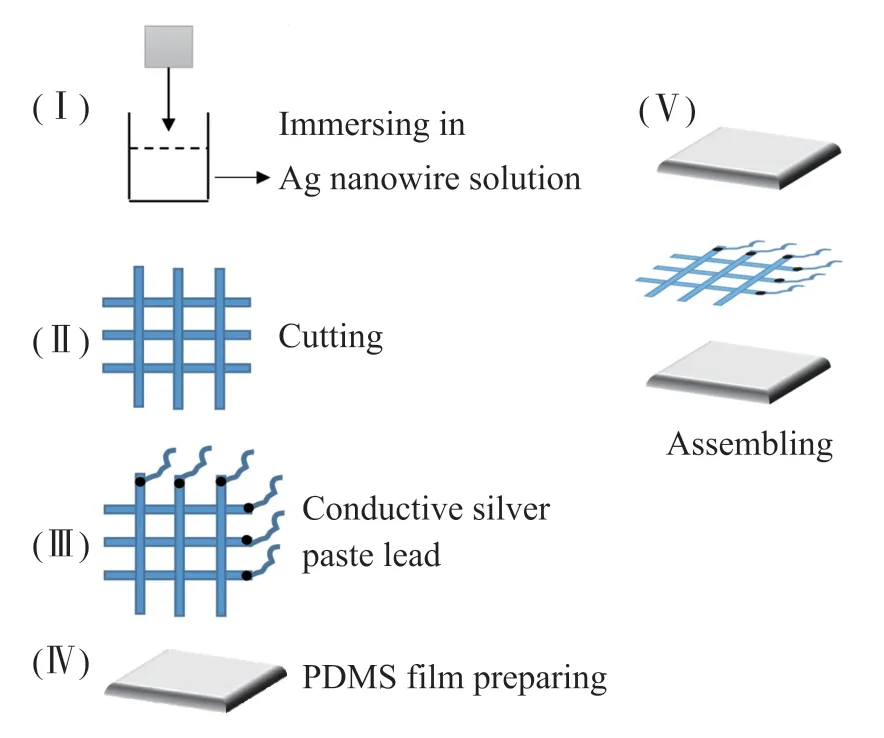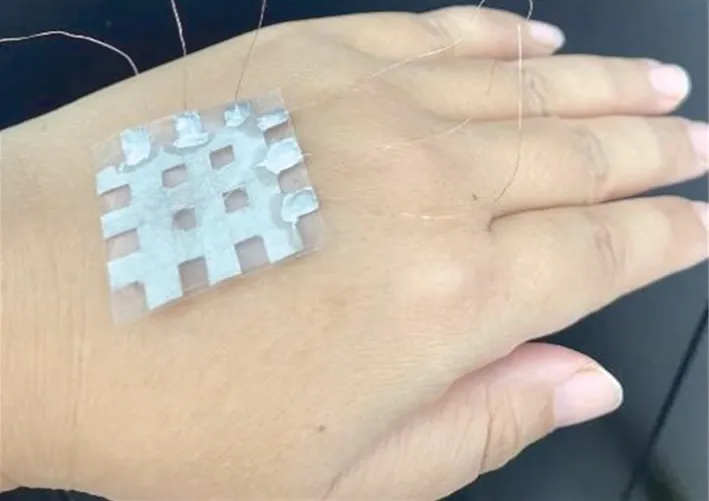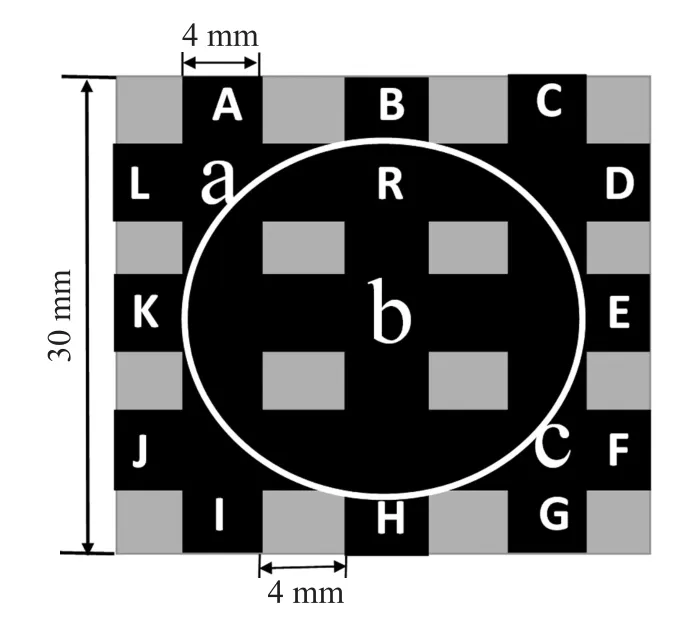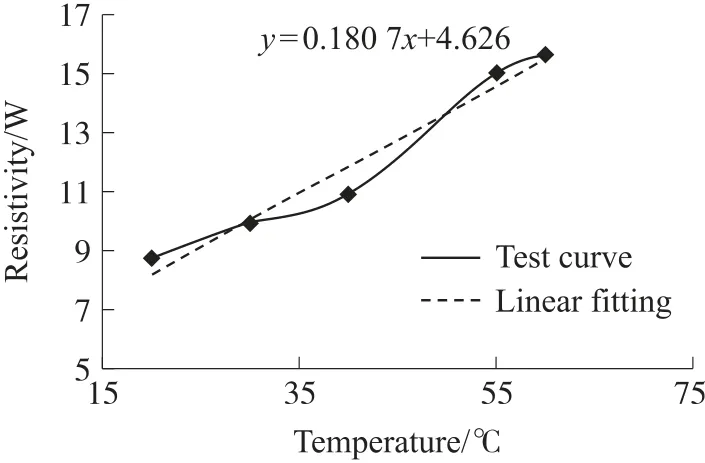Research on Flexible Piezoresistive Tactile Sensor Based on Silver Nanowire*
2024-03-06TANMiaomiaoLIUWei
TAN Miaomiao,LIU Wei
(1.College of Robotics,Beijing Union University,Beijing 100027,China;2.Beijing Engineering Research Center of Smart Mechanical Innovation Design Service,Beijing Union University,Beijing 100027,China)
Abstract: Tactile sensor is the key link for intelligent robot to perceive the external environment and interact with people.Multiple physical measurements and high ductility make tactile sensors more widely used.A flexible tactile sensor with simple manufacturing process and low costs is presented.Based on the change of resistance,it can detect temperature and contact pressure.A sandwich structure of the sensor composed of PDMS film,paper-based silver nanowires and PDMS film is designed.A 3×3 array of paper-based silver nanowires is processed,and copper wires are led out at the end of the array with conductive silver paste.The size of the whole sensor is 3 cm×3 cm.During the experiments,the resistances at the array intersection are measured when applying pressure and changing surface temperature.Results show that the pressure detection sensitivity of the sensor is 2.8 Ω/N and the temperature detection sensitivity is 0.18 Ω/℃.The structure and preparation process of sensor here are simple and feasible,holding broad promise in electronic skin of robots.
Key words: MEMS;flexible sensor;piezoresistive;silver nanowire
By integrating the flexible tactile sensor with the intelligent robot system,the intelligent robot can imitate the process of human tactile response,and replace human beings to complete the work with high precision and in dangerous working environment.Therefore,it can detect a variety of physical quantities and has good ductility,which can make the flexible tactile sensor have a broader application prospect.
Some researchers prepared a flexible tactile sensor array with spatial resolution of 3.5 mm that can be easily worn on the robotic hand.Through the information feedback of sensor,the robotic hand can complete the operation of taking fragile articles without damage[1].Wang Y et al.[2]designed a tactile sensor to envelope the complex-shaped robotic hand finger for grasping force measurement,which concluded 18 sensor units.A stretchable sensor for tactile perception and gesture sensing was designed to integrate on robot fingers.Ag nanowires were used as conductive layer and aggregation induced emission compound served as an active substrate[3].Tactile perception has a wide range of signals,including pressure,temperature,humidity,smoothness and so on.The research of multifunctional flexible tactile sensor is of great significance for the electronic skin application of intelligent robot.Okatani et al.[4]proposed a new design for a tactile sensor that simultaneously measures 6-axis force/torque and the coefficient of static friction,which will enable robotic fingers to handle a slippery object while preventing both translational and rotational slips.Huang et al.[5]invented a system for continuously monitoring blood pulse waves that was integrated with a tactile sensing array and a tension sensor.Lou et al.[6]realized a flexible piezoresistive pressure sensor using a uniform 3D network of conducting film that exhibited excellent sensing properties and enabled monitoring of blood pulse waves and muscle movements.Hua et al.[7]presented a stretchable tactile sensor network of island-bridge structures,which could detect temperature,relative humidity,magnetic field,in-plane strain,ultraviolet light,proximity and pressure.At present,the research of multi-functional flexible tactile sensor is still in the laboratory research stage,and some research findings have been obtained,but further exploration is needed[8-10].
In order to achieve good ductility of flexible tactile sensors,the preparation of stretchable sensitive structure is very important.Wang et al.[11]used porous graphene nanoplate(GNP)/silicone rubber(SR)composites as the sensing material.The sensing element composed of copper conductive film and circular silica gel plate elastomer,which were bonded by silica gel adhesive[12].Park et al.[13]impregnated the isopropanol dispersion of multi walled carbon nanotubes into the patterned porous PDMS,and then covered the surface with conductive fabric to prepare the sensing element.Pressure sensors are prepared using polymer filtered graphene foam,which can be used for static pressure and dynamic pressure measurement[14].Zhong et al.[15]used pressure sensing yarn as the embroidery thread,and prepared the tactile sensor by facile crossstitch on the substrate.Wang X et al.[16]provided a stretchable sensor array using Ag nanofibers and PDMS.Wang S et al.[17]used polymer materials to prepare a transistor array with good ductility.Hou et al.[18]invented a tactile sensor using Ag nanofibers and silk fibroin,which has stretchability of over 60%.Cheng et al.[19]developed electronic skin using Ag nanowires.The electrodes of most flexible tactile sensors are made of metal film[20-21],which still has some limitations in ductility and environmental adaptability.The study of new electrodes and processing methods is of great significance to optimize ductility.
In this study,a flexible tactile sensor was developed and tested,which can detect both pressure and temperature.It has the advantages of simple manufacturing process and low cost,which can make it easier to be processed and applied.
1 Materials and Methods
1.1 Structural design
The sandwich structure is formed by two layers of flexible films and paper-based silver nanowire films,as shown in Figure 1.In order to facilitate the measurement of force distribution,an array structure is designed.Figure 1(a) is the side view of the structure and Figure 1(b) is the top view.Compared with other flexible substrates,PDMS has good ductility and thermal stability.The flexible films are made of PDMS in this study.Silver nanowires are deposited on filter paper.In order to lead out the resistance signal,conductive silver paste is used to connect copper wires at the end of silver nanowire array.

Fig.1 Structural diagram of silver nanowire flexible tactile sensor
Silver nanowires have large specific surface area.When a certain number of nanowires are deposited on the film,the nanowires contact each other to form a large number of conductive channels.When pressure is applied to the film,the contact state between silver nanowires will change,resulting in the change of the output resistance of the film.Silver nanowires deposited on thin films can be sensitive to pressure.At the same time,metallic silver itself has small resistivity and large thermal resistance effect.The resistance will change with the change of ambient temperature.Silver nanowire films can be sensitive to temperature.Therefore,the flexible piezoresistive sensor based on silver nanowires and flexible substrate designed is expected to detect the two physical quantities of pressure and temperature.
1.2 Fabrication procedure
Figure 2 illustrates the fabrication process of the sensor.Firstly,a piece of filter paper with thickness of 1mm and size of 3 cm×3 cm was immersed in a silver nanowire solution with a concentration of 5 mg/mL for 48 h,in which the diameter of the silver nanowire was 30 nm.Then,the filter paper was put into 60 ℃incubator for drying.After 10 minutes,it was taken out and cooled naturally to room temperature.Next,the filter paper covered with silver nanowires was cut into 3×3 arrays.The width of each row and column was 4 mm,and the gap between two rows and columns was both 4 mm.Then,the copper wire was fixed at each end of the paper-based silver nanowire array with conductive silver paste.Finally,PDMS film,paper-based silver nanowire array and PDMS film were stacked and packaged with electronic sealant.

Fig.2 Fabrication process of sensor
The process of preparing PDMS film was described as follows.Firstly,polydimethylsiloxane(Dow Corning PDMS 184) main solution and auxiliary solution were mixed according to the mass ratio of 10 ∶1 and stirred evenly.After standing for 5 hours,the PDMS solution was spin-coated on 3 cm×3 cm silicon wafer substrate pretreated with toluene.Then the substrate was placed on a hot plate with the temperature of 90 ℃for 1 hour to cure.Next,the prepared PDMS film was removed from the substrate.Then another PDMS film was prepared to the same thickness.The thickness of PDMS film prepared was 100 μm.The prepared flexible tactile sensor was shown in Figure 3.

Fig.3 The prepared flexible tactile sensor
2 Results
2.1 Pressure sensitive experiment
The pressure sensitivity test of the prepared sensor array was carried out.Figure 4 shows the experiment system for measuring the resistance response of the sensor under vertical downward force.The experiment system consists of a vertical electric instrument,a regulated DC power supply and a high-precision current measuring instrument.The upper surface of the sensor was in close contact with the output rod of the pressure gauge installed on the vertical electric instrument.As the output rod moved downward,a vertical pressure was applied to the sensor.At the same time,the value of the pressure was measured by the pressure gauge in real time.

Fig.4 Pressure sensitive experiment system
The section of the output rod was a circular area with a diameter of 20 mm.As shown in Figure 5,the circular interior was the area where the sensor array was under pressure.As 100 mV DC voltage was applied on the column of array,current was measured on the row by galvanometer.Then the resistance at the intersection of the column and the row was calculated.Three intersections on the diagonal of 3×3 array were taken as the resistance test points,which were named a,b and c from top to bottom.The test points for the resistance of point a,b and c are AL,BK,GF respectively.

Fig.5 Circular area of sensor array under vertical force

Fig.6 Relationship curve between resistance and pressure
The relationship curve between resistance change and pressure of array a,b and c were shown in Figure 6.Results indicated that when the applied pressure increased from 0.1 N to 5 N,the resistances of the three test points all gradually decreased with the increasing pressure,and the resistance variation range was 5 Ω-35 Ω.The resistances of point a and c were less than that of point b in the whole range.By linearly fitting the data points of point b,the pressure detection sensitivity of the sensor is 2.8 Ω/N.
As shown in Figure 6,both the resistance of point a and point c were less than that of point b under the same pressure.Since this designed Ag nanowire array had the same size of row width and column width,and the spacing between columns and rows was equal,so the resistance of each black square area in the array could be assumed to be equal and set as the smallest unit resistance ofR.Considering the shortest path of the circuit,the resistance of point a measured by AL and point c measured by GF could be approximated as the series of three unit resistance,that is 3R.The resistance of b measured by BK was two groups of 4Rin parallel and twoRin series,that is,the total resistance was 4R.Therefore,the initial resistance at point b was greater than the resistance at points a and c without pressure.At the same time,point b was completely covered by the applied force area,while point a and c were partially covered.Therefore,the resistance value of point b was greater than the resistance value of point a and point c during the test.The experimental results showed that the resistance value of point c was greater than that of point a in the test range.It was considered that the contact resistance between conductive silver paste and array electrode at G and F leads were larger。
The resistance decreased gradually with the increase of pressure,which could be caused by the reduction of the gap between silver nanowires or the contact of more nanowires to form more conductive channels when a large number of disorderly deposited silver nanowires were extruded.
The distribution of silver nanowires is disorderly.There are two possibilities of direct contact and air separation between the nanowires.Since the energy of electrons in the metal is lower than that of free electrons in the air gap,the air gap plays the role of tunneling barrier.The silver nanowires with air gap constitute a sandwich structure with two conductors sandwiched by a barrier layer,which is the model of electron tunneling barrier[22].Tersoff and Hamann modeled the probe as a sphere with the radius ofR.The closest distance from the bottom of the sphere to the metal surface isd.The expression of tunneling conductance between STM probe and metal surface is derived,as shown in Equation(1).
Whereσis the tunnel conductance andkis the reciprocal of the minimum attenuation length of the metal surface wave function in vacuum.Equation(1)shows that the tunneling conductance decreases exponentially and rapidly with the increase of the spacingd.
The silver nanowire is simplified as a series of nanoscale spheres with the radius ofR.The ratio of the length of the nanowire(L) to the radius(R) is the number of nanospheres that make up the entire nanowire.The contact part of two nanowires is approximately discretized into contact pointsNcalong the length direction.The contact resistances of each contact point are connected in parallel.The total conductance is the sum of the tunnel conductance of each discrete unit,and the scope of sum is the contact length of two silver nanowiresLc.The number of contact units isNc=Lc/R.The total conductance of the contact part between nanowires is shown in Equation(2).
Combining Equations (1) and (2),the tunnel conductance of the contact part between silver nanowires increases with the decrease of the gap or the increase of the contact length.When the pressure is applied to the silver nanowire film,the contact gap of the nanowires decreases and the contact length increases,so the total conductance of the silver nanowire film increases,that is,the resistance decreases.
2.2 Temperature sensitivity test
The temperature sensitivity of the prepared sensor array was tested.As shown in Figure 7,the temperature test system consists of a galvanometer,a DC power supply and a heating plate.The sensor array was placed on the workbench of the heating plate.When the temperature of the heating plate changed in the range of 20 ℃-60 ℃,the change in resistance of the sensor was measured.Different from the pressure distribution measurement in the pressure measurement process,the whole sensor array was in the same temperature environment in the temperature test.Since all points were consistent under the influence of temperature,only point b in Figure 5 was tested.

Fig.7 Temperature sensitivity test system
The variation curve between resistance at point b and temperature was shown in Figure 8.When the temperature changed in the range of 20 ℃-60 ℃,the output resistance of sensor increased with the increase of temperature.By linearly fitting the data,the change rate was 0.18 Ω/℃.The resistivity of metal increases with the increase of temperature,and silver nanowires are metal nanomaterial.Therefore,according to the resistance expression,the resistance of the sensor will increase with the increase of temperature.The sensor array can realize the sensitive measurement of object surface temperature.

Fig.8 Curve of resistance with temperature
3 Conclusions
In this study,a flexible tactile sensor which can detect contact pressure and surface temperature was proposed.The paper-based silver nanowires were used as the sensitive layer and packaged with upper and lower PDMS films to form a sandwich structure.The array structure of paper-based silver nanowires provided favorable conditions for the detection of force distribution.The experiment of applying vertical pressure to the sensor showed that the resistances of the sensor gradually decreased when the pressure increased from 0.1 N to 5 N.Comparing the resistance values of different points on the sensor array,it was found that the larger the area under pressure,the larger the output resistance.The pressure detection sensitivity of the sensor was 2.8 Ω/N.The experiment of temperature test showed that the output resistance of sensor increased when the temperature increased in the range of 20 ℃-60 ℃,and the temperature detection sensitivity is 0.18 Ω/℃.The reasons why the output resistance of the sensor decreased with the increase of pressure and increased with the increase of temperature were analyzed in this paper.Resultsindicated that based on the change of resistance,the sensor could detect the contact pressure and surface temperature,and the structure and preparation process are simple and feasible.
